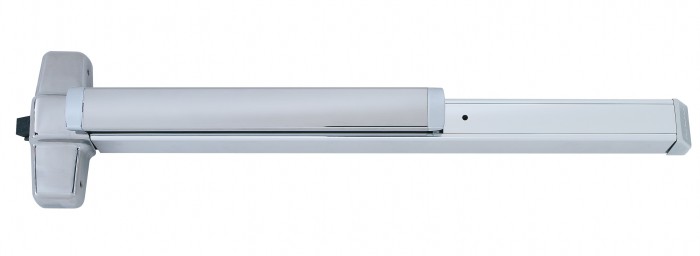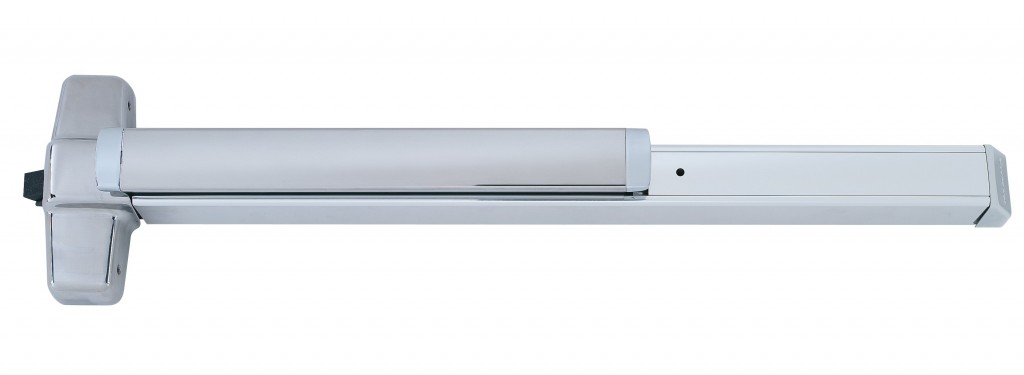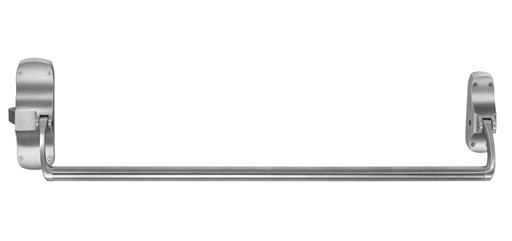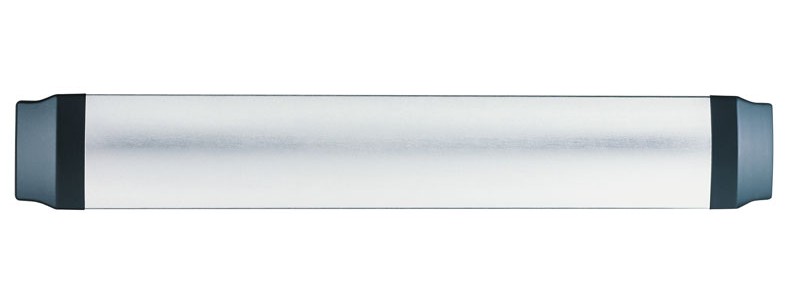Question: What’s the difference between panic hardware and fire exit hardware? And what’s an exit device?
Answer: An exit device is the general term for panic hardware, a panic device, or fire exit hardware. An exit device may be of the touchpad, crossbar, or recessed style, and it’s characterized by an actuating mechanism that spans at least half the width of the door. If the length of the touchpad or crossbar is at not least half the width of the door, the hardware is not code-compliant.
Panic hardware is an exit device which has been tested and certified to meet the requirements of the UL 305 – Panic Hardware test standard. One of the requirements of this standard is that the hardware must unlatch when a maximum 15-pound force is applied to the touchpad or crossbar.
Fire exit hardware is panic hardware which has also been tested per UL 10C – Positive Pressure Fire Tests of Door Assemblies, or another fire test standard. Because fire doors are required to positively latch, mechanical dogging – holding the latch retracted with a key or tool, is not allowed on fire exit hardware. The dogging function may be accomplished electrically, as long as the latches project automatically upon fire alarm.
The locations where panic hardware or fire exit hardware must be installed are indicated by the International Building Code and NFPA 101 – The Life Safety Code. The National Electric Code (NFPA 70) also requires panic hardware for certain electrical room doors.
~~~
Related Posts:
You need to login or register to bookmark/favorite this content.









Lori:
Welcome back? I assume you’re in Country. Maybe you can touch on the length of the device (push pad) in relationship to the door width. We end up fighting with contractors all the time on this. Our rule of thumb is any door over 3′ wide you use a 4′ device.
John
Yes, I’m back. I did mention the length of the touchpad in the first paragraph of my answer, but I added another line to clarify. Thanks!
Do you see many new balanced door installs???
I wouldn’t say that I see a lot of them, but I do see them on occasion. Half the time they get value-engineered out.
I have found hardware bearing the “Panic Hardware” label in locations requiring “Fire Exit Hardware” on a few occasions during my 37 years. The problem seems to occur because contractors installing the hardware are not aware of the distinction. The wrong hardware is usually easy to detect by looking for some means of “dogging” the hardware on a required fire door into the unlatched state such as an unfilled hole or presence of hexagonal set screw somewhere. Most often one finds the flat style bars have a small plastic plug in the hole where the dogging mechanism would be accessed but not all. The UL label is the best clue however.
It is interesting on the difference in hardware aspect for the contractors as we have found too. Some of the contractors here in BC Canada have the same problem with the difference.
Maybe we should talk about the fire doors for being different so they know what is what. Yes I agree Jerry, is that not what the label is for? So than making it right the first time is to be sure the contractors have the right stuff to do the job in the first place. YES that is another BLOG all in its self too. This is a great site and great work on all this Lori!!!
Thanks Robert!
I LIKE TO KNOW IF THE LOWER VERTICAL ROD CAN STAY CLOSE WHEN THE UPER ROD IS ALWAYS OPEN ON THE Crossbar Style Exit Device – Von Duprin 88 Series VERTICAL ROD
Question for you on a classroom door that’s designate and exit door should there be a Panic device or will just a lever do for the handle to exit. Our school site was upgraded with bond money and the entire school was switched to the panic device except two doors?
Thanks for your time!
Jj
Hi JJ –
Panic hardware is required for doors in schools that are serving a room or area with either 50 occupants or more (2006 International Building Code and subsequent editions) or 100 occupants or more (2000 and 2003 IBC and NFPA 101). Whether it’s 50 or 100 will depend on what code your jurisdiction has adopted. States and local jurisdictions sometimes modify the codes, so the local requirements may be different. The occupant load of the room is based on the square footage and the use of the room. For example, the IBC uses a factor of 20 square feet per person for classrooms, so if a classroom is 1000 square feet, the occupant load according to the IBC is 50.
– Lori
Ok, with all if this in mind, what if the door has no label, and or the door isn’t fire rated?
Isn’t it more important that the occupants will exit in the case of fire?
What role will it being dogged open play?
The closer will push door shut to contain a fire or smoke.
Hi Tony –
If the door is not fire-rated it can have panic hardware, which almost always has the dogging mechanism. But whether the panic is dogged or not, people will still be able to exit. A fire door with a closer but no latch may be forced open by the pressure from a fire.
– Lori
is the span coverage of the exit different for Fire Rate & Non Fire Rate Doors?
Hi Alex –
If you mean the span of the actuating portion of the device, it is the same for both panic hardware and fire exit hardware. It has to be at least half the width of the door.
– Lori